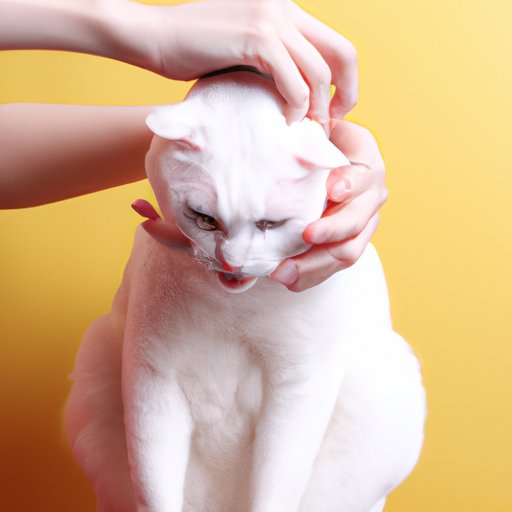Introduction
Have you ever petted a cat and heard the delightful sound of purring coming from your feline friend? You may have wondered why cats purr when you pet them, and if it is a sign that they are happy and content. As it turns out, purring is one of the many ways that cats communicate with their owners, other cats, and the world around them. In this article, we will explore the science behind feline purring behavior, decipher what your cat’s purring really means, and debunk some common myths about this fascinating behavior.
The Science Behind Feline Happiness: Understanding Why Cats Purr When You Pet Them
Cats have a unique way of producing a purring sound that is different from other animals. While the exact mechanism behind the purring sound is not entirely understood, it is believed to be produced by the vibrating of muscles in the larynx and the diaphragm. These muscles contract and relax in a rhythmic pattern, producing the characteristic sound that we associate with feline purring.
So why do cats purr when you pet them? Contrary to popular belief, cats do not purr only when they are happy and content. While purring can indeed signal that a cat is feeling relaxed and content, it can also indicate that they are in pain or distress. For example, a cat that is sick or injured may purr as a way to soothe themselves and reduce their anxiety.
Scientific research has demonstrated that purring can have therapeutic benefits for both cats and humans. According to a study published in the Journal of the Acoustical Society of America, the sound frequency of a cat’s purr falls within a range that is known to have therapeutic effects on the body. The frequency of a cat’s purring can help reduce stress, lower blood pressure, and improve bone health.
The Ultimate Guide to Cat Body Language: How to Tell When Your Feline Friend is Purring with Pleasure
Like many animals, cats use body language to communicate their feelings and intentions. Understanding cat body language is key to interpreting what your cat’s purring really means. In addition to purring, cats display a variety of other cues when they are enjoying petting. For example, they may knead their paws, rub their head against you, or wag their tail.
When a cat is purring out of contentment, their body language will often be loose and relaxed. They may stretch out, expose their belly, and half-close their eyes. On the other hand, a cat that is in pain or distress may show signs of tension and anxiety. They may hunch their back, flatten their ears, and tense their muscles.
Cracking the Code of Feline Communication: Deciphering What Your Cat’s Purr Really Means
Purring behavior is not limited to expressing contentment or pain. In fact, cats use purring to communicate with their owners and other felines in a variety of ways. For example, a mother cat may purr as a way to calm her kittens and signal that everything is safe and secure. Similarly, a cat may purr as a way to signal that they are not a threat to other cats in the area.
Different types of purrs can indicate different things. For example, a low-pitched, rumbling purr may indicate that a cat is feeling relaxed and content. A higher-pitched purr, on the other hand, may indicate that a cat is feeling anxious or in pain. Similarly, a cat may use a short, staccato purr to signal that they are feeling playful and energetic.
The Health Benefits of Petting Your Purring Pals: How Spending Time with Your Cat can Improve Your Mood and Reduce Stress
Cats are known for their ability to bring joy and comfort to their owners, and scientific research has demonstrated that spending time with cats can have mental and physical health benefits. Petting and interacting with cats can help reduce stress, anxiety, and depression. In fact, owning a cat has been shown to have a positive impact on mental health outcomes, including decreased feelings of loneliness and improved mood.
The act of petting a cat can also trigger the release of feel-good hormones in the body, such as oxytocin and serotonin. These hormones can help reduce stress and improve overall mood. Additionally, caring for a pet can give owners a sense of purpose and fulfillment, which can also contribute to mental health and well-being.
Feline Myths: Separating Fact from Fiction on Why Cats Purr When You Pet Them
There are many myths and misconceptions surrounding why cats purr when you pet them. One of the most common myths is that cats only purr when they are happy and content. However, as we have seen, cats may also purr when they are in pain or distress. Another myth is that all cats purr, when in fact some cats do not possess the ability to purr, such as the big cats of the wild.
It is also important to note that cats are individuals, and their purring behavior may vary depending on their personality and experiences. Some cats may be more vocal than others, while some may purr more loudly or softly than others. By paying attention to your cat’s body language and other cues, you can better understand what their purring behavior really means.
Conclusion
In conclusion, understanding why cats purr when you pet them is key to understanding feline communication. It is important to recognize that cats use purring in a variety of ways, and that their purring behavior may not always signal happiness and contentment. By learning to read your cat’s body language and other cues, you can deepen your bond with your feline friend and better understand their needs and desires. So the next time your cat purrs when you pet them, you can appreciate the complexity and beauty of this unique feline behavior.
